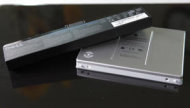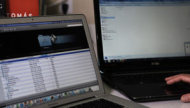First, the basics
Most laptops use batteries that can last for 3-5 years, or about 1000 charges. (A premium laptop's battery might last longer.) Every time you charge your battery, the total capacity of the battery is diminished. Originally it may have had a run time of 3.5 hours, but after a year it'll run out of juice at 3 hours, even on a full charge.

If your battery capacity has diminished, there are a few things you can do about it. First, you have to correctly gauge how much capacity has been lost. There are free downloads to do this job, like Battery Bar (for Windows PCs) or Coconut Battery (for Macs). These will compare your battery's current maximum capacity to how long it lasted when it was new.
(UPDATE- we originally recommended Battery Eater and while the program works great, their download site has been compromised and we are recommending an alternate program, Battery Bar downloadable from CNET.)
Battery calibration
No miracle can restore the battery capacity. You lose power over time due to chemical reactions that take place in the battery, as you chug along power your laptop. You can not undo the changes, but it is a common problem with the battery, you can set: In many portable, battery meter function becomes out of sync with the amount of juice from the battery.

Imagine if the gas gauge on a car dashboard has been a misreading of the amount of gas that have been in the tank. It is run out of gas when you thought you had a quarter tank left, or if you were filling up too often. The laptop, this could mean the laptop turns off suddenly when the counter says that you have 30 minutes to go. Or the meter may indicate that you only have 2 minutes of battery life left, and turn off the laptop down when in reality it is still 20 minutes left.
Recalibrate the battery meter reads correctly the current state of the battery, so the operating system and know your position in the life of the existing community.
How to recalibrate
First, the battery on your laptop as a whole, and leave it for at least two hours. Unplug your laptop, and set your power management settings to not turn off or decrease the brightness of the screen. (HP has instructions on how to do this in Windows 7 and Vista, and Windows XP, while Apple has instructions for Mac laptops on their website.)
Want to discharge the battery completely, then let your laptop rest of at least five hours that way - as, for example, at night. (Just be careful and reduced volume, as some laptops have an audible warning when running low.) Then, reload, and you will notice a clearer picture of the battery capacity. In some cases, you can even get more life out of it.
Comments
Post a Comment